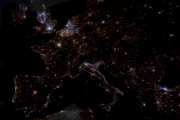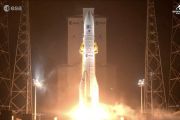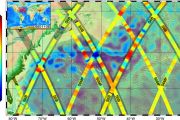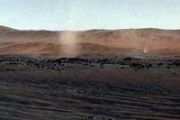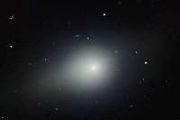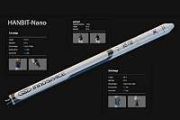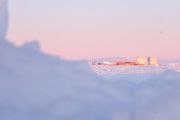
Copernical Team
NASA conducts 1st hot fire of new RS-25 Certification Test Series
 NASA conducted the first hot fire of a new RS-25 test series Oct. 17, beginning the final round of certification testing ahead of production of an updated set of the engines for the SLS (Space Launch System) rocket. The engines will help power future Artemis missions to the Moon and beyond.
Operators fired the RS-25 engine for more than nine minutes (550 seconds), longer than the 500 secon
NASA conducted the first hot fire of a new RS-25 test series Oct. 17, beginning the final round of certification testing ahead of production of an updated set of the engines for the SLS (Space Launch System) rocket. The engines will help power future Artemis missions to the Moon and beyond.
Operators fired the RS-25 engine for more than nine minutes (550 seconds), longer than the 500 secon Large swings in past ocean oxygen revealed
 As the climate warms, there is major concern that Earth's ocean will lose oxygen. A study published recently by oceanographers at the University of Hawai'i at Manoa revealed that locked in ancient deep-sea sediments is evidence for oxygen loss in the world's ocean during past glacial periods, indicating that widespread oxygen loss with current climate change may not be permanent.
Scientist
As the climate warms, there is major concern that Earth's ocean will lose oxygen. A study published recently by oceanographers at the University of Hawai'i at Manoa revealed that locked in ancient deep-sea sediments is evidence for oxygen loss in the world's ocean during past glacial periods, indicating that widespread oxygen loss with current climate change may not be permanent.
Scientist New Siena Galaxy Atlas delivers improved measurements of almost 400,000 nearby galaxies
 Astronomers have created a detailed atlas of almost 400,000 galaxies in our cosmic neighborhood. The Siena Galaxy Atlas was compiled using data from NSF's NOIRLab telescopes, and is designed to be the pre-eminent digital galaxy atlas for large galaxies. It's a treasure trove of information for researchers investigating everything from galaxy formation and evolution to dark matter and gravitation
Astronomers have created a detailed atlas of almost 400,000 galaxies in our cosmic neighborhood. The Siena Galaxy Atlas was compiled using data from NSF's NOIRLab telescopes, and is designed to be the pre-eminent digital galaxy atlas for large galaxies. It's a treasure trove of information for researchers investigating everything from galaxy formation and evolution to dark matter and gravitation Grasping the three-dimensional morphology of kilonovae
 An advanced new three-dimensional (3D) computer simulation of the light emitted following a merger of two neutron stars has produced a similar sequence of spectroscopic features to an observed kilonova.
"The unprecedented agreement between our simulations and the observation of kilonova AT2017gfo indicates that we understand broadly what has taken place in the explosion and aftermath," say
An advanced new three-dimensional (3D) computer simulation of the light emitted following a merger of two neutron stars has produced a similar sequence of spectroscopic features to an observed kilonova.
"The unprecedented agreement between our simulations and the observation of kilonova AT2017gfo indicates that we understand broadly what has taken place in the explosion and aftermath," say Searching for concentrated biosignatures in an ancient, Martian mud lake
 A landmark discovery by a collaborative team led by the Planetary Science Institute's Alexis Rodriguez has unveiled evidence of sedimentary plains created by aquifer drainage within Martian collapse formations termed chaotic terrains.
"Our research focuses on a sedimentary unit within Hydraotes Chaos, which we interpret to be the remnants of a mud lake formed by discharges from gas-charged
A landmark discovery by a collaborative team led by the Planetary Science Institute's Alexis Rodriguez has unveiled evidence of sedimentary plains created by aquifer drainage within Martian collapse formations termed chaotic terrains.
"Our research focuses on a sedimentary unit within Hydraotes Chaos, which we interpret to be the remnants of a mud lake formed by discharges from gas-charged Psyche's 3.6 billion kilometre journey to the centre of the Earth via it's namesake
 Psyche was the Greek goddess of the soul, born a mere mortal and later married to Eros, the God of love. Who knows why the Italian astronomer Annibale de Gasparis gave her name to a celestial object he observed one night in 1852?
Psyche was only the 16th "asteroid" ever discovered: inhabitants of the Solar System that were neither the familiar planets nor the occasional visitors known as c
Psyche was the Greek goddess of the soul, born a mere mortal and later married to Eros, the God of love. Who knows why the Italian astronomer Annibale de Gasparis gave her name to a celestial object he observed one night in 1852?
Psyche was only the 16th "asteroid" ever discovered: inhabitants of the Solar System that were neither the familiar planets nor the occasional visitors known as c TRIDENT drill integrated into VIPER lunar rover
 Engineers at NASA's Johnson Space Center in Houston, together with the team from Honeybee Robotics in Altadena, California, are gearing up to incorporate the latest addition to NASA's first robotic Moon rover, VIPER (Volatiles Investigating Polar Exploration Rover). The newly arrived instrument is the TRIDENT drill, an acronym for The Regolith Ice Drill for Exploring New Terrain.
TRIDENT i
Engineers at NASA's Johnson Space Center in Houston, together with the team from Honeybee Robotics in Altadena, California, are gearing up to incorporate the latest addition to NASA's first robotic Moon rover, VIPER (Volatiles Investigating Polar Exploration Rover). The newly arrived instrument is the TRIDENT drill, an acronym for The Regolith Ice Drill for Exploring New Terrain.
TRIDENT i Lockheed Martin Ventures backs HawkEye 360 with $10M in latest funding round
 HawkEye 360 Inc., a front-runner in the provision of space-based radio frequency (RF) data and analytics, has concluded its Series D-1 funding round by securing an additional $10 million. This latest financial injection brings the total amount raised in the Series D-1 to $68 million. Key investors in this second closing were Lockheed Martin Ventures, the investment wing of Lockheed Martin Corpor
HawkEye 360 Inc., a front-runner in the provision of space-based radio frequency (RF) data and analytics, has concluded its Series D-1 funding round by securing an additional $10 million. This latest financial injection brings the total amount raised in the Series D-1 to $68 million. Key investors in this second closing were Lockheed Martin Ventures, the investment wing of Lockheed Martin Corpor Planetary Scientist Alan Stern Joins Virgin Galactic for Research Mission
 Dr. Alan Stern, a leading planetary scientist and the Associate Vice President of Southwest Research Institute's (SwRI) Space Science Division, will fly aboard the VSS Unity, Virgin Galactic's commercial spaceship, on November 2. The upcoming flight is not just a personal milestone for Stern but is set as a precursor to a NASA-funded Virgin Galactic suborbital flight, during which he will execut
Dr. Alan Stern, a leading planetary scientist and the Associate Vice President of Southwest Research Institute's (SwRI) Space Science Division, will fly aboard the VSS Unity, Virgin Galactic's commercial spaceship, on November 2. The upcoming flight is not just a personal milestone for Stern but is set as a precursor to a NASA-funded Virgin Galactic suborbital flight, during which he will execut Rocket Lab Moves Into System Integration Phase for NASA's Mars Mission
 Rocket Lab USA, Inc. has entered a crucial phase in its collaboration with NASA on the ESCAPADE mission, a project aiming to study Mars' hybrid magnetosphere. The company announced that the twin spacecraft for the mission have moved into the system integration phase, aligning with a launch scheduled for 2024.
Spearheaded by Dr. Rob Lillis at the University of California, Berkeley's Space S
Rocket Lab USA, Inc. has entered a crucial phase in its collaboration with NASA on the ESCAPADE mission, a project aiming to study Mars' hybrid magnetosphere. The company announced that the twin spacecraft for the mission have moved into the system integration phase, aligning with a launch scheduled for 2024.
Spearheaded by Dr. Rob Lillis at the University of California, Berkeley's Space S 

